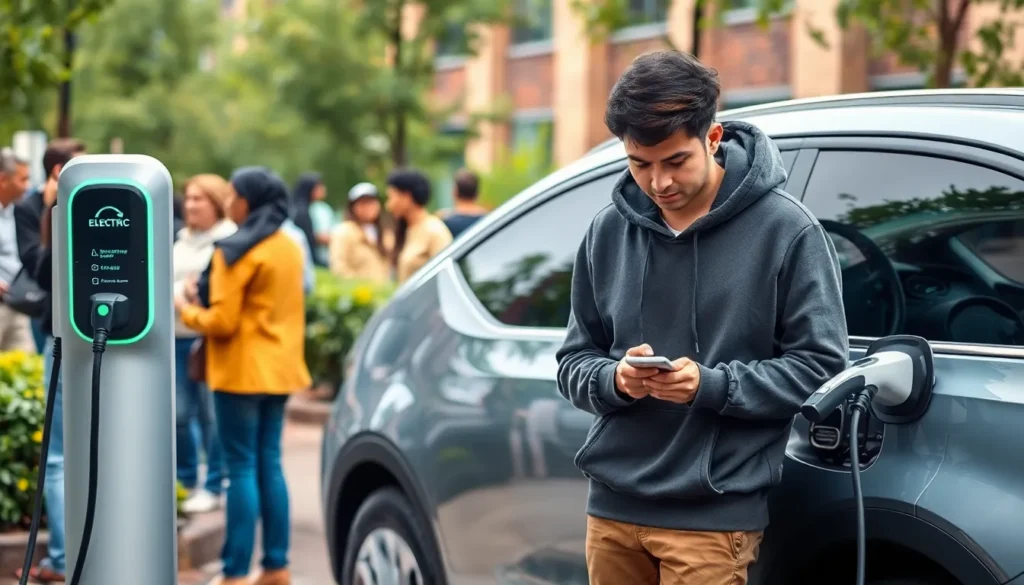In a world where gas stations are as common as coffee shops, electric charging stations are the cool new kids on the block. They’re popping up faster than you can say “eco-friendly,” and for good reason. With the rise of electric vehicles, these charging hubs are transforming how people think about fuel. Forget the smell of gasoline; it’s all about plugging in and powering up now!
Table of Contents
ToggleOverview Of Electric Charging Stations
Electric charging stations provide essential infrastructure for electric vehicles. These stations come in various types, including Level 1, Level 2, and DC fast charging options. Level 1 chargers typically utilize a standard household outlet, delivering around 4-5 miles of range per hour. Level 2 chargers offer a more robust solution, providing 10-60 miles of range per hour, making them suitable for both public and residential use.
DC fast chargers excel in speed, delivering up to 80% charge in as little as 30 minutes for compatible vehicles. Stations equipped with these chargers often feature reliable payment options and user-friendly interfaces, enhancing the overall experience for electric vehicle owners.
The expanding network of electric charging stations is vital for promoting electric vehicle adoption. According to the Department of Energy, over 100,000 public charging connectors exist across the United States, reflecting a steadily growing commitment to sustainable transportation. Location matters; charging stations commonly appear in urban areas, shopping centers, and along highways, providing convenient access for drivers.
Charging station usage trends indicate that many drivers prefer stations near their homes or workplaces. Fast charging stations are increasingly popular among long-distance travelers, supporting the functionality of electric vehicles beyond daily commuting. Continued investments in charging infrastructure align with governmental initiatives, aiming for widespread electric vehicle integration by 2030.
Accessibility is critical, as municipalities prioritize equity in charging station distribution. Cities implementing comprehensive charging networks ensure all residents can benefit from electric vehicle technology. Regular updates on charging station locations and technology advancements contribute to an informed consumer base.
Types Of Electric Charging Stations

Electric charging stations come in various types, catering to different needs and charging speeds. Each type offers unique benefits, making it essential to understand their distinctions.
Level 1 Charging Stations
Level 1 charging stations utilize standard household outlets, making them easily accessible. Typically, they provide a charging rate of 4 to 5 miles of range per hour. Owners often plug their electric vehicles into these outlets overnight, benefiting from a convenient, low-cost charging option. This method suits drivers with shorter commutes or those with access to a dedicated parking space.
Level 2 Charging Stations
Level 2 charging stations offer a faster charging rate compared to Level 1, providing 10 to 60 miles of range per hour. These stations require a specialized installation and typically draw 240V. Level 2 options are common in public charging networks, workplaces, and shopping centers. Drivers frequently find them ideal for quick stops during errands or at work, enhancing the overall convenience of electric vehicle ownership.
DC Fast Charging Stations
DC fast charging stations deliver rapid charging, allowing electric vehicles to gain 60 to 80% of their battery capacity in just 30 minutes. These stations utilize direct current, providing up to 350 kW of power. Ideal for long-distance travel, they are commonly located along highways. Drivers appreciate the ability to recharge quickly while on road trips, making DC fast charging stations crucial for expanding the usability of electric vehicles.
Benefits Of Electric Charging Stations
Electric charging stations offer numerous benefits that support both individual and societal goals. They promote a cleaner environment and deliver financial savings to users.
Environmental Impact
Electric charging stations significantly reduce greenhouse gas emissions. Transitioning from gasoline to electric vehicles lowers air pollution levels, enhancing urban air quality. Studies show shifting to electric transportation decreases reliance on fossil fuels and mitigates climate change effects. Renewable energy sources further enhance environmental benefits by powering these stations, creating a sustainable energy ecosystem. Infrastructure investments in charging stations spur advancements in battery technology and energy efficiency. Access to charging stations enables more consumers to adopt environmentally friendly vehicles, strengthening green initiatives.
Cost Savings
Cost savings represent another clear advantage of electric charging stations. Electric vehicle owners often enjoy lower fuel costs compared to traditional vehicles. Charging at home typically costs less than filling up with gasoline, enabling substantial savings over time. Incentives such as tax credits and rebates reduce the initial investment for purchasing electric vehicles. Many public charging stations offer free or low-cost charging, further enhancing savings. Over the lifespan of the vehicle, electric car owners can expect to save thousands on maintenance and fuel. Altogether, these financial benefits encourage wider adoption of electric vehicles and foster a shift toward sustainable transportation alternatives.
Challenges Facing Electric Charging Stations
Electric charging stations face several challenges that hinder their effectiveness and growth. Understanding these obstacles can help address the needs of electric vehicle users.
Infrastructure Limitations
Infrastructure limitations present significant barriers to the expansion of electric charging stations. Insufficient charging points often stem from outdated electrical grids that lack the capacity to support numerous fast chargers. Many locations do not have adequate space for new installations, particularly in urban environments where land is scarce. Charging stations can experience downtime due to maintenance issues, which can further frustrate users. Regular updates and investments in infrastructure are essential for supporting the growing demand from electric vehicle owners. Strategic planning in urban design must incorporate charging needs for seamless integration into existing systems.
Accessibility Issues
Accessibility issues affect the availability and convenience of electric charging stations. Locations frequently cluster in urban areas or affluent neighborhoods, leaving rural communities underserved. Many drivers encounter challenges finding charging stations, especially in suburban regions. Public charging stations may not always comply with the Americans with Disabilities Act, limiting access for individuals with disabilities. To enhance equity, stakeholders must consider the distribution and accessibility of charging stations for all demographics. Consistent updates on station locations and availability can alleviate user frustrations and foster a more inclusive electric vehicle ecosystem.
Future Trends In Electric Charging Stations
Electric charging stations are poised to evolve rapidly in the coming years. Significant advancements in technology and network expansion will transform how vehicles recharge.
Technological Advancements
Charging stations are adopting faster charging technologies to meet increasing demand. Wireless charging systems are becoming more prevalent, allowing vehicles to charge without physical connections. Integration of smart technology improves user experience by providing real-time data on station availability and charging speed. Additional innovations include solar-powered charging stations that utilize renewable energy for sustainability. Investing in automated systems enhances parking management at charging sites, leading to more efficient use of space. Such advancements ensure that electric vehicle owners enjoy convenient and speedy charging options.
Expansion Of Charging Networks
The expansion of charging networks is critical to meet the growing electric vehicle market. Plans exist to increase the number of charging stations from over 100,000 to hundreds of thousands in the coming years. Urban areas and highways will see an increase in charging access, catering to both daily commuters and long-distance travelers. Partnerships between private companies and municipalities aim to strategically place stations in underserved regions. Initiatives focused on equitable distribution will ensure that not only affluent neighborhoods benefit from improved access. Developing charging hubs in commercial centers can also promote electric vehicle adoption.
The rise of electric charging stations marks a pivotal shift in transportation. As the network expands and technology advances, accessibility and sustainability remain at the forefront. Communities are increasingly recognizing the importance of equitable charging solutions to support electric vehicle adoption.
With the ongoing development of faster charging options and innovative technologies, the future looks promising for electric vehicle owners. The commitment to reducing environmental impact while enhancing convenience will drive further advancements in this sector.
As more drivers embrace electric vehicles, the infrastructure supporting them will continue to evolve, ensuring a cleaner and more sustainable future for all.













